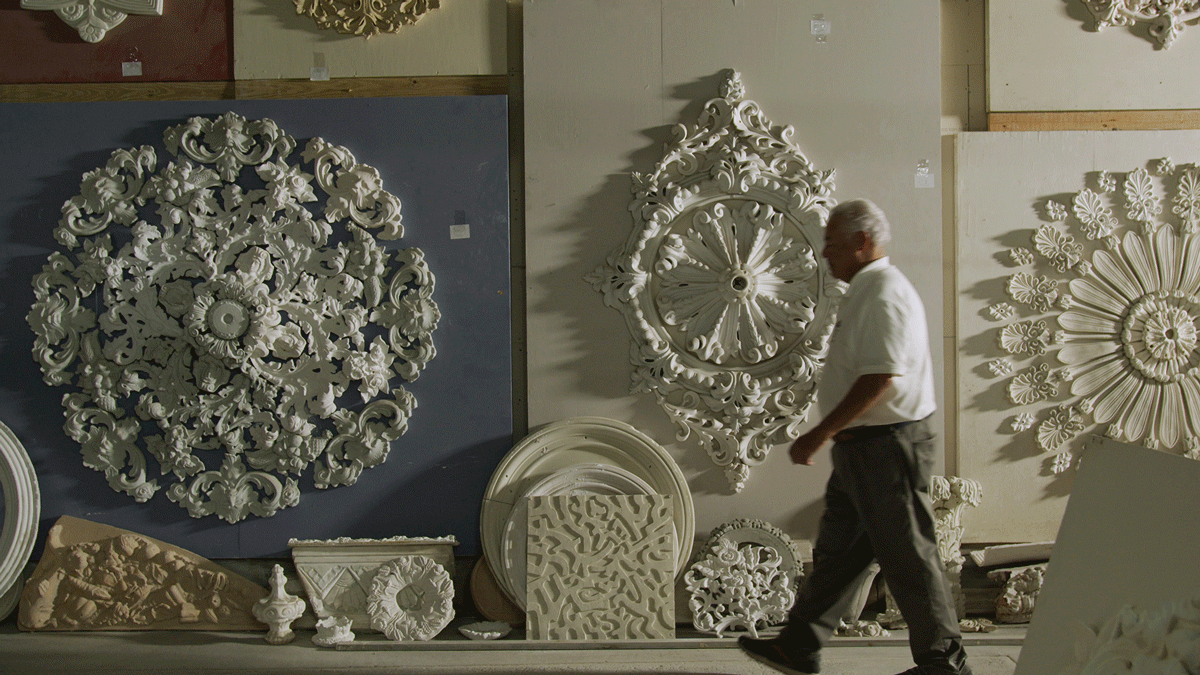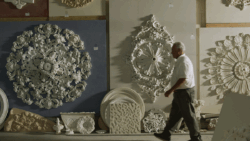Current Issue
Ancestral Artistry
Published: May 30, 2025
Last Updated: May 30, 2025

Louisiana Architecture Foundation
Master Plasterer Jeff M. Porée, Sr. walking in front of ceiling medallions that he and his team crafted.
The hour-long documentary Ancestral Artistry: The Influence of Africans & Creoles of Color on Louisiana Architecture, produced by the Louisiana Architecture Foundation (LAF), opens with three men discussing the challenges of restoring the Craftsmen’s Tomb in the iconic St. Louis Cemetery No. 2 in New Orleans. The only way to restore this tomb is to disassemble the top and work downward—no small feat for even the most accomplished laborer.
The challenge is set, and viewers begin a journey into the lives of men whose skills as master craftsmen helped build and beautify Louisiana’s architecture.
The LAF website notes the documentary’s focus on “the building trades that—over the past 300 years—produced the distinctive architectural forms that distinguish Louisiana’s built environments from other parts of the United States.” Co-directed by Conni Castille and Charles E. Richard and co-produced by Allison Bohl DeHart and Peter DeHart, the film combines history, architecture knowledge, and interviews to explore the contributions of enslaved Africans and free people of color to Louisiana’s monumental beauty.

Louisiana Architecture Foundation
Ancestral Artistry also examines the impacts of French and Spanish colonization, Creole culture, Southern economics, and environmental challenges in shaping the state’s architecture. Documentary narration is anchored by commentary from experts such as Dr. Tara Dudley from the University of Texas at Austin School of Architecture; New Orleans historian Lynette Dolliole Johnson; esteemed architect Edward Jon Cazayoux; Dustin Fuqua, Chief of Resource Management at Cane River Creole National Historical Park; and John E. Hankins, co-founder of New Orleans Master Crafts Guild.
However, the film’s center are the enslaved people, Creoles of color, and eventually African Americans who mastered trades such as masonry, blacksmithing, plasterwork, carpentry, and farming. These craftsmen were able to establish their economic independence with extraordinary skills that were hard to replace. “New Orleans is one of the few places where people of color rose to prominence in building trades,” says Hankins in the film. Yet, because of their historically inferior racial and social status, those craftsmen never got the recognition they deserved.
Some of Louisiana’s contemporary Black master artisans featured in the documentary include master plasterer Jeff Porée; blacksmith Darryl Reeves, and master brick mason Theodore “Teddy” Pierre Jr. They express how their journeys into manhood were shaped by their abilities to make a living and provide for their families. The labor of these men is not only precise but is also a form of artistry hard to duplicate without generational expertise. Together, their stories highlight a long, proud tradition of skilled men who created their own networks of expertise and resources built on family names with a reputation for excellence.
LAF is a non-profit dedicated to advancing architecture in Louisiana by serving as a link between the public and the architectural profession. True to its mission, the LAF film connects viewers with the craftsmanship and artistry of men unknown in history books but well respected in their communities. Through stories from men who have mastered their trades, the film underscores the importance of passing knowledge on and not letting honorable trades and old traditions die, while providing a vital account of the unseen hands that helped build Louisiana’s rich architectural history and its trade community.
Kelly Harris-DeBerry is a poet and the author of Freedom Knows My Name. Read and listen to more of her work at kellyhd.com.
